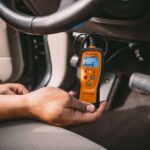The 2004 Ford F150 uses the OBD2 (On-Board Diagnostics II) system. OBD2 became the standard in most vehicles sold in the United States after 1996, replacing the older OBD1 system. This means if you’re working on a 2004 F150, you’ll need an OBD2 scanner to diagnose any issues.
Understanding OBD Systems and the 2004 F150
OBD systems allow mechanics and vehicle owners to access diagnostic trouble codes (DTCs) stored in the vehicle’s computer, providing insights into potential problems. The shift from OBD1 to OBD2 brought significant improvements, including standardized diagnostic connectors and more comprehensive diagnostic capabilities.
While some vehicles manufactured in the early to mid-1990s might have been transitional models with some OBD1 characteristics, the 2004 Ford F150 is firmly within the OBD2 era. There’s no need to worry about compatibility issues with OBD1 scanners or software.
Using OBD2 on Your 2004 F150
With an OBD2 scanner, you can retrieve DTCs, monitor engine performance data (such as fuel/air ratio, timing, and coolant temperature), and even reset the check engine light. This information can be invaluable in diagnosing and fixing issues, potentially improving fuel economy and overall performance.
For example, if you suspect a problem with your F150’s fuel efficiency, as mentioned in the original post, an OBD2 scanner can help you monitor parameters like fuel trim and oxygen sensor readings to pinpoint the cause. This is far more efficient than relying on guesswork or manual testing methods.
A standard OBD2 connector
Beyond OBD2: Further Improving Fuel Efficiency
While OBD2 is essential for diagnostics, other factors can significantly impact your 2004 F150’s fuel economy. These include tire pressure, air filter condition, driving habits, and mechanical issues like transmission drag or faulty spark plugs.
Regular maintenance, such as ensuring proper tire inflation, using a clean air filter, and adhering to a consistent maintenance schedule, can contribute to better gas mileage.
 Mechanic working on a car engine
Mechanic working on a car engine
Regular maintenance is crucial for fuel efficiency and overall vehicle health.
Addressing mechanical problems, like a failing water pump or inefficient cooling system, can also lead to significant fuel economy improvements. As discussed in the original post, upgrading to a more efficient electric water pump and optimizing airflow can significantly reduce engine strain and improve mileage.
Conclusion: Embrace OBD2 for Your 2004 F150
The 2004 Ford F150 unequivocally uses the OBD2 system. Utilizing an OBD2 scanner is crucial for diagnosing issues, monitoring engine performance, and ultimately improving your truck’s efficiency and longevity. Combined with regular maintenance and addressing any underlying mechanical problems, you can ensure your 2004 F150 runs smoothly and efficiently for years to come.
